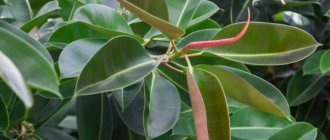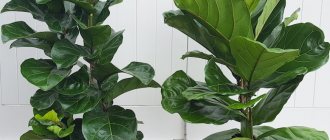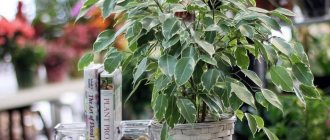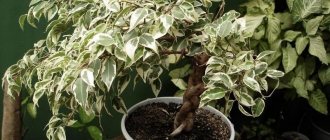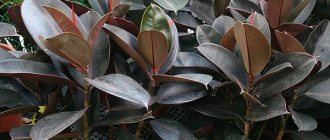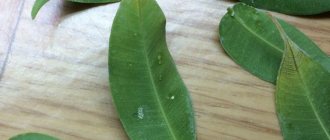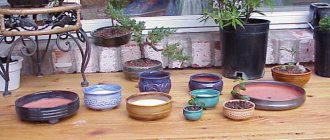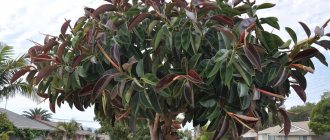Ficus microcarpa is an evergreen tree belonging to the mulberry family.
Initially, it grew naturally only on the island of Borneo, located in Southeast Asia.
Later he began to move to Bermuda and some tropical areas of the United States of America. In the wild, this type of ficus is a very strong and hardy plant. It is sometimes called Ficus microcarpa moclame.
Ficus microcarpa Ginseng bonsai care at home. Description
Ginseng, also known as microcarpa or small-fruited ficus, belongs to the Mulberry family.
In Latin, its scientific name is Ficus microcarpa ginseng.
In natural conditions, it is an evergreen tree 15-25 meters high with a dense spreading crown, a powerful trunk and huge aerial roots hanging down.
In indoor culture, it is most often grown in the form of a bonsai with a small trunk, but a huge rhizome, shaped like a ginseng root. It is no coincidence that “ginseng” is translated as “ginseng”. The tropics and subtropics of Southeast Asia are the tree’s usual habitat.
This representative of the flora is also called “Indian laurel”, “green island” and “Chinese banyan”.
Its dark green leathery leaves are quite large - up to 15 cm in length.
They are oval in shape and have a glossy surface.
Ginseng is a strangler ficus.
Starting life as an epiphyte, as it develops it takes root next to the host tree, entwines it and strangles it, preventing it from developing.
The bizarre rhizome for which the indoor ficus ginseng is famous does not occur in nature.
It is grown on farms using a special technology that is kept secret.
The tree is fed with special preparations and kept in special conditions.
When the root reaches the desired thickness and shape, the plant is transplanted into another container, leaving most of the rhizome on the surface of the soil.
At the same time, the trunk is cut off and new greenery is grown.
Indoor forms with an ordinary trunk are also bred on farms.
In this case, the rhizome is hidden in the ground and the main beauty of the tree is given by the luxurious dense crown.
Charming bonsai trees will not leave anyone indifferent. Most of all, gardeners loved the following tree-like ficuses: Benedicta, Bengal, Carica, Lirata, Microcarpa, Eden, Large-leaved, Impatiens, Retuza and Obtunded. You will find all the rules for growing them on our portal.
Advice from experienced
In new conditions, the ficus experiences quite a lot of stress, so you should know the following aspects of caring for a new flower:
the ficus "Ginseng" tolerates movement extremely negatively, so it must be immediately placed in a permanent habitat and not moved anywhere in the future; the plant does not like wind and strong drafts; ficus reacts poorly to direct ultraviolet rays and excessively dry air - try to choose a site for it so as to provide acceptable living conditions; the flower pot should be located away from radiators and other heat sources in the house; it is optimal to place it on the windows on the west, north-west or north side; if the plant you have chosen has a variegated shape, then it will need more light - it makes sense to place such a ficus on southern or southeastern windows; in the first days after purchasing a plant, it is important to ensure an optimal level of humidity in the chosen place - to do this, the pot must be placed in a small tray with moistened pebbles; you should spray the leaves every day with a spray bottle and, if possible, turn on a humidifier or at least an indoor fountain for 2–3 hours a day
Ficus microcarpa Ginseng home care forum. Ficus ginseng care at home
Ginseng or ficus microcarpa ginseng is a species of ficus plant belonging to the Mulberry family. The similarity of the presented flower with ginseng lies only in the thick trunk, which looks like a root. Although it is very difficult to create a “mandrake root system” at home.
In nature, this species can reach a height of 25 meters. As for home conditions, we are usually talking about dwarf plants that look like bonsai.
For good growth, ficus needs to create optimal conditions, which include:
- choosing the right microclimate;
- high-quality watering;
- competent feeding.
The right microclimate - what is it like?
Ficus ginseng does not tolerate direct sunlight, so you should not place a flower pot on a windowsill where the sun constantly shines.
However, it is also impossible to hide the plant in the shade. It is advisable to give the flower a bright, but not brightly lit place, where the temperature will not drop below +16..+18 °C. Important! Ficus is a flower that does not like to be moved, so it should not be carried from place to place.
High-quality watering
Many gardeners make a big mistake by watering a flower with tap water, believing that nothing bad will happen, since rainwater is no cleaner. Perhaps, but it does not contain chlorine and salts that negatively affect the soil and the entire plant. At home, you should water the flower only with settled, melted, rain or purified water.
And the manipulation is performed as follows:
- The procedure begins only when the substrate in the flowerpot dries 2-3 cm deep.
- The flower loves spraying, but it is advisable not to water the aerial roots and trunk abundantly. It is recommended to wipe the sheet plates with a wet cloth from time to time.
- If it is desirable to carry out irrigation daily, then the plant should be watered no more than twice a week in the summer, and no more than once every 10-14 days in the winter.
Particular attention should also be paid to the air humidity in the room, which should be at least 50%.
Fertilizer application
Without fertilizing, not a single flower will grow and delight the grower with the splendor of its crown or the abundance of flowers. And although ficus ginseng does not bloom at home, it can boast of the rich color of its leaf plates. Therefore, it is necessary to fertilize the pot with the plant once every 2 weeks, alternating organic matter with mineral fertilizers.
Ficus transplant
A young flower is replanted every year; a plant that has reached two years of age needs the procedure every 2-3 years.
By the way, it is absolutely normal if the leaves of a flower you just bought and brought home begin to fall off. This is how the plant reacts to changing conditions.
When replanting ficus microcarpa ginseng, it is important to use special soil. It can be neutral or slightly acidic. A similar substrate is sold in flower shops, but you can make it yourself.
In order to do this, you will need to take:
- sand – 1 part;
- leaf soil - 2 parts;
- turf soil - 2 parts.
Some gardeners also add peat soil or charcoal to the composition. Having mixed it all thoroughly, we can assume that the soil mixture is ready.
There is an opinion that there is no need to replant ficus ginseng bonsai. They say it is enough to trim the roots. It is not true. Considering that the presented type of ficus, like all others, contains poisonous juice, which gradually affects the composition of the substrate, replanting should be performed without fail.
Methods for creating ginseng bonsai
It’s hard to argue with the fact that ficus ginseng looks amazing as a bonsai. It is not surprising that many gardeners strive to give their flower exactly this shape. Moreover, it is not difficult to do this. First the trunk is formed. To do this, you can carefully tie the top of the crown to the trunk with threads, and then very carefully tie the entire ficus with wire.
After 2 months, this entire structure is removed. This procedure will create special scars that decorate the plant.
As for the crown, it is formed just as simply. If you want to get a ball shape, then the side shoots are regularly cut off, and the upper branches and leaves are pruned. We must remember to thin out the crown so that the shoots do not create an unnecessary “forest” inside.
Flower propagation methods
If you know how to care for a plant, you can get not only a beautiful bush, but also the opportunity to grow ficus trees.
The most popular methods are:
- propagation by cuttings;
- propagation by root cuttings;
- propagation by air layering.
Propagation by cuttings
This type of reproduction is performed in the following order:
- In spring, it is necessary to cut cuttings with several leaves from the tops.
- After this, the shoots should be placed in water for 2 hours, which will need to be changed periodically.
- Next, the cuttings are placed in a pre-prepared substrate and covered with a bag.
The gardener should place the flowerpot with cuttings in a bright and warm room. At this stage, the rules of care are reduced to ventilating the greenhouse and brief watering.
After 2-3 months, when the cuttings take root, they can be planted in new pots.
Propagation by root cuttings
In order to propagate a flower in this way, you should cut off part of the root from an adult ficus, and then place it in water for several hours. Next, the root is planted in a peat-sand mixture and covered with film.
When the first leaves appear, the film can be removed, and after a while the young plant can be transplanted into a flowerpot.
Reproduction by air layering
This method is not used as often as the others. To begin with, the gardener must make a small cut around the bark, apply moistened moss on top and then wrap the whole thing with film.
Important! It is necessary to keep the sphagnum wet, and do not forget to ventilate such a greenhouse.
When roots appear, the top is cut off and transplanted into a separate container.
Simple rules will allow the gardener to grow a beautiful ficus ginseng.
Possible diseases and pests
If not properly cared for, ficus microcarpa can become infected with spider mites, which cause the leaves to become entangled in cobwebs and then fall off.
If the foliage of the plant becomes sticky, it means that a scale insect has settled on the plant.
In these cases, you need to immediately wash all parts of the ficus with a solution of green or laundry soap, and then spray with an insecticide solution.
Of the diseases for this type of ficus, the most dangerous are root rot, which occurs due to excessive watering. In this case, you need to transplant the plant into new soil, first removing the affected areas of the root system, and the remaining part should be treated with a fungicide.
Ficus microcarpa Ginseng home care. Reproduction
Ficus Ginseng can be propagated in three different ways: cuttings, seeds or air layering. It is almost impossible to sow microcarpa at home, so gardeners are left with the two methods described above.
- You can grow your own bonsai from cuttings. At the very beginning of spring, branches that have already become covered with hard bark are cut off and placed in a vessel with water for the next two weeks. In the first 1-2 days, the plant will release milky sap, which helps heal wounds and inhibits root growth, so the water needs to be changed at least twice a day.
- Reproduction by air layering is a more complex, but most effective method. On one of the strengthened branches of Ginseng, the bark is cut off (in a rectangle of approximately 2-3 centimeters). Afterwards, the cut site is wrapped in damp moss, covered with film and left in this state until the roots sprout. Then the cellophane is removed, the seedling is cut and planted in the ground immediately with moss, which will act as a natural fertilizer.
- Root cuttings are another method of propagating ficus plants. This method is the simplest, but not all seedlings take root. It is necessary to separate approximately a quarter of the rhizome. Afterwards, the roots are transplanted into a separate pot. The cut piece should protrude about 2-3 centimeters from under the ground.
Features of care in winter, rest period
Ficus Robusta rubber - planting and care at home
Ficus dormancy begins in the second half of November and lasts until the end of April and the first days of May. The tree must be kept at room temperature. Phytolamps are used as additional lighting. Watering in winter is moderate. If the air is dry due to central heating, the plant is sprayed 1-2 times a week.
Attention! Do not allow the air in the room to cool to a temperature below +15 °C.
Caring for ficus microcarpa Ginseng. Care at home
Ficus microcarpa does not require complex care. This flower prefers bright, diffused sunlight. But you can also choose artificial lighting for it. It is placed closer to the window, but away from heating sources. The optimal temperature in summer is considered to be 20–23 degrees Celsius. In winter, the indicator should not be less than 16. If the summer is very hot, care includes constant ventilation and spraying. The plant needs a lot of moisture during the period of intensive growth.
In winter, the reference points are air humidity, temperature and degree of illumination. When kept in a cool, dark room, the need for water is reduced significantly. Ficus microcarpa ginseng loves high air humidity - spraying should be carried out 1 - 2 times a day. And once every 2-3 weeks the culture is washed under a warm shower. To increase humidity when caring for a plant, a tray with wet expanded clay is often used.
The culture requires well-drained, soft and fertile soil with a slightly acidic or neutral reaction. You don’t have to buy ready-made soil, but prepare it at home by taking turf, leaf, peat soil and sand in equal parts, adding charcoal. Care includes applying complex fertilizing once every 2 weeks. Universal fertilizers are recommended for decorative foliage plants or bonsai. In winter, 1 feeding per month is enough. Ficus microcarpa responds positively to foliar feeding. Care involves replanting young specimens once every 2 years with a complete renewal of the earthen layer.
Photo
In the photo there is a ficus "Microcarpa":
He needs regular transplants. They do this once every two or three years.
There is no need to replant annually, but partial replacement of the soil is recommended. Transfer to a new container is carried out together with the old substrate.
The exception is transplantation after purchase. The substrate in which the plants are sold is not suitable for long-term cultivation and must be completely replaced.
Before the procedure, the plant is not watered to make the roots easier to clean. A layer of drainage is poured into a new container, then soil for the ficus. The mixture can be purchased ready-made, special.
If this is not possible, make it yourself from leaf turf, sand and peat in equal quantities.
To maintain low acidity, charcoal is added to the composition.
Place the tree in the center of the pot or slightly offset it and fill the empty space with soil. Compact it by lightly tapping the container.
The size of the pot should be 3-4 centimeters larger than the previous one. If you do not want the ficus to increase in size, you can not change the dishes, but only replace the soil mixture.
Ficus bonsai microcarpa Ginseng. Bonsai Ficus Ginseng
1
Ficus Ginseng, or Ficus microcarpa, or Ficus obtuse in natural conditions reaches 25 meters in height. In foreign literature it is called Indian laurel, green island and Chinese banyan. In his homeland - in East Asia, on the island of Borneo - he is called the Strangler. Ficus, with the help of aerial roots, wraps itself around the trunks of neighboring trees and interferes with their growth - “strangles”.
- In the wild, ficus Ginseng is found in Southeast China, Japan, the Philippines, Taiwan, Indonesia, and Northern Australia. It grows very quickly and is unusually hardy. Ficus sprouts in all places it finds itself: in sidewalk cracks, on rocks, on the roofs of multi-story buildings.
- picking soil, sand and clay granules in equal quantities;
- turf soil, leaf soil and sand (in a ratio of 2:2:1), you can add charcoal;
- turf soil, peat soil, leaf soil and sand in equal parts.
- change of conditions;
- draft;
- sudden changes in temperature;
- excessive watering and root rotting.
miniature tree
In indoor conditions it is grown as a bonsai, the height of which does not exceed 50 centimeters. Recently, it has become fashionable to give bonsai as a gift. Although this plant is an oriental one, having recently appeared in the CIS countries, it has managed to win a place for itself in our souls. Ficus Ginseng is often called ginseng. It was given this name because its root is similar in appearance to ginseng root or the fabulous mandrake root. A small tree with a bizarrely curved trunk was especially loved by men.
But it should be noted that such a trunk was not given to it by nature, but was formed using special agricultural technology.
Bonsai blooms with small spherical inflorescences painted purple. The inflorescences are about 2 centimeters in diameter and resemble berries. Later, real berries are formed from the flowers. They are not used for food: ficus berries are not poisonous, but have a disgusting taste. But at home, ficus flowering is very rare.
Location
Did you receive a Ficus Ginseng as a gift? Let's find a permanent place for it, protected from direct rays, but not completely dark. The best choice for the plant would be partial shade. Ficus does not like drafts, but there is no place for it near a radiator. The optimal temperature for ficus is +16…+22C. What he doesn't like most is sudden temperature changes.
In summer we take the flower out onto the balcony or veranda.
Ficus care
Ficus Ginseng is not picky and does not require special conditions.
Watering
Despite its small growth, the plant has huge aerial roots and loves moisture. Water as needed, not allowing the earthen ball to dry out. But ficus does not like waterlogged soil. For irrigation we use only settled water.
We spray the bonsai and wipe the leaves with a damp cloth every day.
It's okay if the leaves start to fall - this is a reaction to the new conditions. With proper care, the bonsai will produce new leaves. To help him adapt faster, we spray him with an epin solution.
Top dressing
During the period of active growth (spring-summer), we feed it twice a month with full mineral fertilizer and organic fertilizer, alternating them. Yellowing of the leaves indicates a lack of minerals.
Transfer
Every spring until the age of 5, we transplant it into a new container. Then we carry out transplantation once every 2-3 years. When replanting, shorten the ficus root by a third.
For planting, we take purchased soil for ficuses or prepare the soil ourselves.
Substrate options for planting:
We pour expanded clay onto the very bottom of the flower pot, and crush the top of the soil with sand.
Trimming
We form the crown after 3-4 years, leaving 3-4 leaves on the branches. The plant tolerates pruning easily. If the ficus is not trimmed, it will stretch out and lose its resemblance to a bonsai. We monitor the appearance: promptly remove damaged and dried shoots.
Pests and diseases
Sometimes ficus is attacked by mites, scale insects, whiteflies, aphids, and thrips. In this case, we treat the plant with Actellik.
The green leaves on the ficus may suddenly fall off. The reasons for this phenomenon:
If yellow leaves fall off, this phenomenon indicates:
- insufficient watering;
- dry air;
- lack of sunlight;
- lack of minerals.
Reproduction
With proper care, Ficus Ginseng will delight you with its appearance for a long time. You can grow it yourself from cuttings, root suckers, air layering or seeds. But with independent propagation, an ordinary ficus will grow. You won't be able to get a bonsai.
If you decide to grow a ficus from a cutting, you should not overwater it. In case of excessive moisture, the cuttings rot. Cut the cuttings to a length of 10 centimeters, leaving 3 pairs of leaves. We process the cut using root or heteroauxin. We plant the cuttings in the soil-sand mixture and cover with a jar. After rooting, we transplant it to a permanent place of growth.
This hardy, original and distinctive plant will charm you and become your favorite.
Botanical description
Ficus microcarpa is a tree-like plant of the Mulberry family (Moraceae). Its natural habitat is the tropical forests of Japan, China, the Philippines, Malaysia, India and Australia. Ficus usually grows on trees as an epiphyte, reaches a height of more than 20 m, and is sometimes capable of completely entwining a support with thick aerial roots. It blooms only in the wild with spherical inflorescences (syconia). The flowers are heterogeneous, small, up to 2 cm in diameter. At first, syconia have a golden color, but as they ripen they become cherry. In place of the flowers, small fruits are formed, after which the flower received its name.
At home, the size of the ficus does not exceed 1.5 m. As it matures, the aerial roots rise above the ground, intertwine and bend into a variety of shapes. On short petioles there are glossy elliptical leaves 10 cm long and 4-5 cm wide.
Ficus Ginseng transplant after purchase. Benefits and harms
- Ficus ginseng is not only a beautiful ornamental plant, it has numerous beneficial properties:
- rids the air in the apartment of harmful substances - phenol, benzene, formaldehyde fumes;
- saturates the air with oxygen;
- has a beneficial effect on the energy of the room.
In addition, it is widely used in folk medicine for the treatment of diseases such as mastopathy, fibroids and other neoplasms. Tinctures based on the milky juice of the plant are used in the complex treatment of arthrosis, radiculitis, and osteochondrosis.
From the frozen milky juice of ficus, lotions are prepared for hematomas, bruises, warts and papillomas. Medicines are also made on its basis, for example, suppositories for hemorrhoids.
In most cases, ginseng is safe for people, but experts do not advise growing the plant for those who are prone to allergic reactions. The milky sap secreted by the tree can provoke the development of rhinitis, fever, and headaches.
Did you know? In the list of the most powerful household allergens, ficus is in third place, losing first place to pets and dust mites.
Beneficial features
Indoor ficus microcarpa helps purify the air from various harmful carbon compounds, for example: phenol, benzene and formaldehyde. It is believed that this tree has a positive effect on energy in a confined space. It was noticed that if there is a similar ficus in the house, then its residents are less susceptible to illness, and if they do get sick, they recover very quickly.
According to psychologists, homemade ficus helps improve mood and maintain peace of mind. Esotericists are confident that such a tree attracts prosperity into the house. At the same time, there is an assumption that the larger it is, the stronger its ability to bring joy and benefit to people.
Ficus Microcarpa (Part 1).
Difficulties in growing
It often happens that a green friend begins to behave strangely, and his owner does not understand the reason for this behavior. The most common vagaries of flowers and their causes:
Check if the lighting is ok. Perhaps the ficus microcarpa received a sunburn.
Falling leaves
There may be several reasons for this: insufficient watering, stress from moving to a new place, change in temperature, the appearance of ants in the ground, lack of light.
All this should be identified and eliminated. But if everything is simple with watering and light, then getting rid of ants will be much more difficult. Special products sold in the flower department will help.
This indicates that it lacks nutrients. In this case, complex flower fertilizer will help.
Darkening of foliage and the formation of spots on it
Most likely the problem is excess moisture. This can happen because the pot in which the ficus is planted does not have drainage holes. It is necessary to transplant the ficus into a new pot suitable for it and carry out regular but low-intensity watering so that the flower returns to normal.
Spider mite
The lack of humidity is to blame. The tick must be removed from the tree with a cloth dampened with soapy water.
The solution is prepared from warm water, soap and alcohol, the ratio is 1 tablespoon of alcohol: 1 liter of water). And be sure to change the soil in the pot.
It is important
It is not recommended to transfer the plant to a new pot every year if it feels great in the old container. The need for replanting is signaled by roots that peek out of the drainage holes or rise above the surface of the ground. Also, the need to replace the soil is indicated by a stop in growth. In this case, you need to make sure that the ficus has stopped growing not due to disease or pest attacks.
It is not recommended to try to transplant an adult plant alone. Transferring a ficus into a new tub without damaging its roots is much easier with two people. During transplantation, the plant should not be shaken. We must remember that it has very fragile shoots and petioles.
Any careless movement may cause them to break.
Keeping fit
After purchasing a ficus that has already been formed as a bonsai, you need to constantly monitor its shape. Stores use special products called retardants. They slow down the growth of the plant and prevent it from stretching upward. With the end of their action, growth will resume - the leaves will become larger, the branches will stretch upward. If there is a lack of nutrients, the ficus will begin to consume the reserves deposited in the fleshy roots. This will lead to a decrease in their size and compression.
To ensure that ficus microcarpa retains its original appearance, shoots and roots are regularly pruned. Pruning is carried out only in summer! All regrown branches are cut off, leaving 2 pairs of leaves on them. This is a creative process. You need to focus not only on pruning technology, but also on the overall appearance of the plant. First of all, those shoots that violate the desired shape are cut off. Use a sharp tool for cutting!
